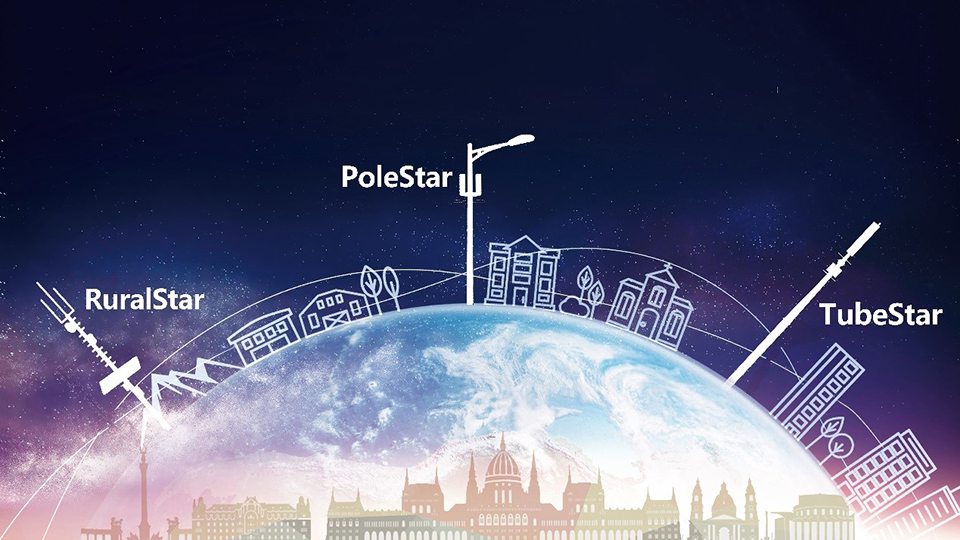S.I.T.E Helps to Achieve Full Connectivity and Deliver Optimal Experience
According to Huawei global industry vision, the volume of traffic generated on mobile terminals will increase from 7% in 2015 to 25% by 2025. In 2025, the daily volume of mobile communication traffic per user will reach 1 GB, which is 30 times greater than that recorded in 2015.
Staying online anytime and anywhere is becoming a growing trend. Universal access services are improving the quality of life and work efficiency, promoting social development and transformation, and advancing economic development.
As the demands for mobile broadband grow exponentially, what can be done to improve network capacity and user experience? During site addition, what can be done to help operators acquire site locations, lower coverage costs, shorten the payback period, and deploy ubiquitous coverage?

Based on the S.I.T.E concept, Huawei has launched a series of scenario-specific, innovative site solutions (PoleStar, TubeStar, and RuralStar) to help operators provide ubiquitous coverage in urban areas, coverage holes, and remote areas, bridge the digital divide, and make mobile communication a fundamental right for everyone.

Innovative site solutions play an important role in fulfilling these purposes. S.I.T.E. is short for Simplicity (the art of site: simplified but marvelous), Innovation (cross-domain innovation continuously improves site value), TCO Saving (targeted network deployment minimizes overall site costs in an all-around way), and Ecosystem (adapting sites to different scenarios)
Simplicity: The Art of Site: Simplified But Marvelous
Site installation is simplified to replace traditional towers with only one pole or integrated tubular cabinet (ITC) and allow for easy installation on isolated islands, along highways, in urban areas, mountainous areas, emergent scenarios, and other specific scenarios.
- Simple design: The full-series of blade outdoor BBUs, RRUs, power supplies, and transmission equipment are lightweight and highly integrated. One pole or one ITC is able to host these devices, eliminating the need for an equipment room.
- Flexible deployment: Site devices can be flexibly combined and assembled based on site conditions on mountains, along coasts, in deserts, CBDs, or urban villages.
- Simplified O&M: A digital, network-based, smart, and automatic O&M system makes sites visible, manageable, and controllable. This system allows for refined site operations, proactive management, remote, reliable, efficient, and convenient O&M.
- Easy site acquisition: Huawei and operators partner with supermarkets, power companies, small- and medium-sized towercos, and large property companies to discover potential site locations and acquire such locations in batches through central negotiation.
Innovation: Cross-Domain Innovation Continuously Improves Site Value
Sites are continuously innovated to provide wider coverage in more and more scenarios. Urban smart sites with optional value-added functions play a crucial role in building a smart city.
- Innovative RuralStar2.0 supports multi-RAT, multi-hop, and multi-band deployment for the provisioning of both voice and data broadband services, extends the coverage distance to 60 km, and expands the application scenarios by 30%.
- A smart pole site integrates book RRUs, RRUs, other modules and eliminates the need for optical fibers. Such a site can be deployed wherever electricity is available. Smart functions can be deployed based on site conditions, including electronic billboards, smart power-saving street lamps, cameras, and weather big data monitoring devices, to facilitate a smart city evolution.
TCO Saving: Targeted Network Deployment Minimizes Overall Site Costs in an All-Around Way
Targeted site deployment, innovative technologies, the usage of idle social resources, and site location sharing for cost apportionment optimize site costs in an all-around way from different dimensions and aspects to quickly recoup investment.
- RuralStar performs three transformations to lower the transmission (from satellite/microwave transmission to relay), infrastructure (from high-rise towers to low-rise poles), and energy (from diesel engines to solar power) costs for rural networks. These effectively help to lower the TCO by 50% and shorten the payback period from 10 to between 3 and 5 years.
- PoleStar fully leverages idle municipal and social resources in urban areas, including street lamp, utility, landline, monitoring, and transmission poles, to lower the infrastructure rental cost by 60%.
- TubeStar integrates all devices into an ITC and requires only 2 square meters, reducing the TCO by up to 30%. Two operators can share an ITC to lower the infrastructure cost by 50%.
- RRNs use radio resources to perform backhaul in areas where optical fibers are unavailable and microwave devices cannot be deployed, slashing the transmission cost by 90% and resolving the issue of last-mile transmission.
Ecosystem: Adapting Sites to Different Scenarios
Sites can be flexibly deployed to fit into any potential environment. A large number of idle resources, such as street lamp poles, utility poles, and billboards, are possible site locations that have new commercial value.
- Huawei breaks with the traditional mindset and builds an open, sustainable site ecosystem to fully leverage existing, idle site resources, allowing the industry chain to create new value.
- Huawei partners with operators, towercos, government agencies, and industry partners to draw a blueprint for agile site addition. Sites are deployed on towers, lamp poles, utility poles, and billboards in different areas to provide ubiquitous mobile network coverage.
- More than 2000 lamp poles have been acquired in Saudi Arabia. More than 40,000 lamp and transmission poles have been acquired in Myanmar. More than 40,000 transmission and utility poles have been acquired in the Philippines.
Huawei continuously innovates scenario-specific site solutions based on S.I.T.E. to help operators acquire, plan, design, and deploy sites. These solutions allow operators to take the lead in market competition, improve ROI, quickly deploy sites, and build a fully interconnected, digital world.
The Second Global Site Forum 2018 will be held in Singapore on September 18. The theme of the forum will be Full Connectivity, Optimal Experience, and Win-Win Cooperation. Huawei will present and discuss topics in regards to 5G-oriented site evolution, urban site densification, indoor digitalization, and remote coverage at the Sands Expo & Convention Center, Marina Bay, Singapore.
For more information, please visithttps://www.huawei.cn/minisite/globalsiteforum2018/en/index.html